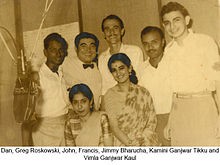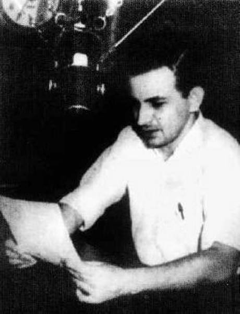When Radio Ceylon ruled the airwaves – by V.S. SAMBANDAN
Magnetic voice of Jimmy Bharucha
Once the pride of the region, Radio Ceylon is today a fading memory. Can the Sri Lankan Broadcasting Corporation regain its lost glory?
IT is Christmas time and Jim Reeves is on air, taking Sri Lanka back to its days of romance and charm. “You are listening to Sri Lanka Broadcasting Corporation and we’ve got more Christmas music going out for you. Hope you are tuned in to us,” trills the friendly announcer. Another glorious old number “When A Child Is Born” floats across the skies. Requests pour in from all over the country and the programme continues to enthral those tuned in.When Sri Lanka Broadcasting Corporation (as Radio Ceylon is now called) celebrated its 80th birthday on December 16, it was, sadly, a pale shadow of its past. Once the pride of the region’s airwaves, it is today relegated to fading memories and confined to chapters of an era of broadcasting élan.
High quality
For Indian radio enthusiasts of decades gone by, it was Radio Ceylon that set the standards. Those were days before commercial broadcasts commenced in India and taking a break from the monotonous, though informative, broadcasts of All India Radio (AIR) meant twirling those vintage radios to trap Radio Ceylon’s programmes. Once tuned in, the listener was treated not just to music of the highest quality. The magnetic voices of broadcasters, Jimmy Barucha (English), Ameen Sayani (Hindi) and Mayilvaganam (Tamil), to mention just three, ensnared the listeners, taking Radio Ceylon to the top slot in the region’s radio network.The history of broadcasting, published in Wikipedia, notes that gramophone music was broadcast from a tiny room in Colombo’s Central Telegraph Office with the aid of a transmitted built by Telegraph Department engineers from the radio equipment from a captured German submarine.
The beginnings
This metamorphosed into South Asia’s first radio broadcasting station, which was inaugurated on December 16, 1925. The real catalyst was to come later, with the shifting of Radio SEAC (South East Asia Command) to Ceylon in 1949. Radio SEAC, was established during World War II for the British servicemen. Radio Ceylon, as it was called from 1949 became a public broadcasting corporation in 1967. Ceylon Broadcasting Corporation became Sri Lanka Broadcasting Corporation in 1972 when the island-nation changed its name.”Sri Lanka was fortunate that Radio SEAC was established to entertain and inform the troops,” recalls Eric Fernando, former Director General, SLBC. “Geographically Sri Lanka was the ideal location because the (transmission) reach could be all over the region, and at the end of the War, we inherited it.”Radio Ceylon, through its music programmes, carved a niche for itself among the region’s broadcasters. Its base of Indian listeners was huge between the 1950s and the 1970s. “We were popular in India because we had a steady supply of English music,” Fernando, who started his career as a broadcaster at SLBC in the mid 1970s said. For Indians of the radio generation, Radio Ceylon was the first introduction to paradise-island and to the world of music. “I first heard The Beatles over Radio Ceylon. We grew up listening to songs over Radio Ceylon. It was part of my growing up,” remembers Nirupama Rao, the Indian High Commissioner to Sri Lanka. In addition to its well-structured English music programmes, Sayani’s “Binaca Geetmala”, revolutionised radio presentation. Having elevated broadcasting to a fine art in the region, Sayani remains etched in the minds of many. Mayilvaganam’s silken voice, with his singsong Jaffna Tamil diction, captivated the ears of Indian listeners. Between them Barucha, Sayani and Mayilvaganam opened up the listeners’ sensitivities to the finer elements that transcended mundane facts. However, there has been a dip in the number of Indian listeners over the years. With Vividh Bharathi – AIR’s commercial services section – Radio Ceylon’s hold was diluted. The cassette revolution, which made music more affordable, the advent of TV, private radio stations and FM broadcasts were other developments. Slowly, but certainly, Radio Ceylon was pushed to the pages of history.Along the corridors of the SLBC’s headquarters, this history remains frozen. Elegant old studios retain their stately charm, complete with original BBC microphones. Groups of musicians and radio-drama artistes continue to use the studios to churn out programmes. However, somewhere, something is missing. Simply put, SLBC lagged behind the times. SLBC should leverage its past and harness itself to the current developments in radio broadcasting. SLBC’s most unique attribute is its archives – home to more than 1,00,000 original records, comprising Sinhalese, Tamil, English and Hindi music. Sunil Shantha Perera, the new Chairman of SLBC plans to digitise the collection and share them with the National Archives. In addition, the originals with the National Archives are to be shared with SLBC. This digitally reformatted music, Fernando points out, could form the basis for a unique programme that will capture the past and lure audiences back.
Future plans
Plans are also on to offer more programmes on the Internet. Presently the Sinhala and Tamil National services and City FM are available on the Internet (>www.slbc.lk) . An improved English content is also on the cards. The SLBC has collaborated with the BBC to share its programmes for six hours every day. Now a new English channel is being planned. “A national radio must have a national English channel,” emphasises Perera. The abolition of licenses for radio sets in the late 1990s had also punctured its revenues. However, deals with the internationally reputed radio stations such as NHK of Japan and DW of Germany have helped bolster its finances. SLBC officials are emphatic that “radio is still popular”, and point to the increasing “car-radio segment”. However, for SLBC to regain its lost slot as the premier broadcaster, the most critical element is fresh thinking, coupled with leveraging its inherent strengths of the past. For, its success will depend on increasing the number of listeners who willingly tune in to that catchy line: “you are listening to Sri Lanka Broadcasting Corporation”.Also see: (https://en.wikipedia.org/wiki/History_of_broadcasting#Sri_Lanka)
Radio Ceylon had a very lucrative arm – the Hindi Service of the station launched in the early 1950s. Millions of rupees in terms of advertising revenue came from India. The station employed some of the most popular Indian announcers who played a vital role in establishing Radio Ceylon as the ‘King of the Airwaves’ in South Asia, among them, the Ganjwar sisters, Vimla and Kamini, Vijay Kishore Dubey, Gopal Sharma, Hasan Razvi , Vijaylaxmi Ripusudan Kumar Ailawadi, popularly known as Kumar and Manohar Mahajan, Sunil Dutt (who went on to become a film star in Bollywood), Ameen Sayani and elder brother Hamid Sayani though not hired by Radio Ceylon became popular by using Radio Ceylon for broadcasting programs like “Binaca Geetmala” (first broadcast in 1952) and “Lipton Ke Sitaare.”

What captured the Indian listener were the film songs, the golden age of Hindi film music was in the 1950s and 1960s – Radio Ceylon was at the right place at the right time to reach out to the target market of millions of listeners – the station popularised the movie songs, including the talents of playback singers Asha Bhosle,[32] Lata Mangeshkar, K.L. Saigal, Kishore Kumar, Mukesh, Mohammed Rafi, S. Janaki and others. This was a brilliant move by Radio Ceylon as Bollywood film music was banned by All India Radio and other Indian radio stations at the time.[33] This led to increased listenership for radio programmes such as Binaca Geetmala. Radio Ceylon had a captive audience. The Binaca Hit Parade was presented by ‘happy go lucky’ Greg Roskowski, it was a countdown of English pop music beamed on the Commercial Service and the All Asia Service. Having heard the programme, Indian listeners flooded the station with letters requesting a count down of Hindi film songs and the idea of Binaca Geetmala was born.[34]
Radio Ceylon also popularised the English songs of Indian popular musicians – they went on to score huge hits, among them Uma Pocha( Bombay Meri Hai ), Usha Uthup who has the rare distinction of singing Sri Lankan bailasongs with ease and the Anglo-Indian star, Ernest Ignatius ( who went on to be a success in Sir Andrew Lloyd Webber‘s ‘Bombay Dreams‘ in London ) had a massive hit, I Married a Female Wrestler, on Radio Ceylon.[35]
The station was an advertiser’s dream – thousands of jingles were recorded and beamed on the All Asia Service – from Lux soap to Coca-Cola. Major brands queued up for their jingles to be broadcast live by the announcers over the airwaves of Radio Ceylon, such was the station’s advertising power.[36] Masterminding the revenue from India was Radio Ceylon’s advertising agent, Hari Haran, from Radio Advertising Services.
Source: Radio Ceylon – Wikipedia
https://en.wikipedia.org/wiki/Radio_Ceylon
I Married A Female Wrestler (Original) – Ernest Ignatius
https://www.youtube.com/watch?v=QnZb5rlfo48
Radio Ceylon, the first ever radio station in the South East Asia popularized English songs of the Indian artists back in the 60s and 70s. This paved the way for some of the biggest names in India today, such as Usha Uthup to score huge hits. When the pioneering broadcaster late Vernon Corea played Ernest Ignatius’s ‘I Married A Female Wrestler’ (recorded in 1969) for the first time on Radio Ceylon English Service, it became an instant hit. Later on Sri Lanka Broadcasting Corporation, which Radio Ceylon is now called, went on to play ‘I Married A Female Wrestler’ over and over in the 70s. It has remained a popular hit today, even after some 40+ years since it was first introduced by Vernon Corea.
Bombay Meri Hai – Uma Pocha – with lyrics
This is the original version of the song, sung by Uma Pocha (Usha Uthup’s elder sister). It was released in 1969 and became an instant hit. It was a regular feature at weddings and parties even many years after its release. This song became popular not only in India but also in Sri Lanka and inspired a Sinhala cover version entitled “Ran Ran Ran”. It was recorded twice: one as a solo by Milton Silva and the other as a duet with Anjalin Gunathilaka accompanying Milton Silva
THE JETLINERS – BOMBAY MERI HAI 1969
Bill Forbes (alias Kal Kahn) with lyrics
Ladies Of Calcutta – Bill Forbes (alias Kal Kahn)
Bill Forbes – Marianne









No Comments